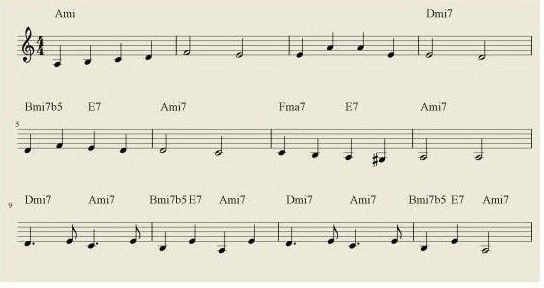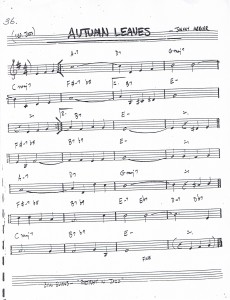Analyses of Minor Key Songs
Who would have thought that the coming Chinese New Year has brought some inspiration to my current blog post! Well, to be specific it’s the little ditty which I know only as “Gong Xi, Gong Xi, Gong Xi Ni-ah! Gong Xi, Gong Xi, Gong Xi Ni!”
And the reason I’m writing about this is because it’s in minor key! Have a look at my transcribed lead sheet with a lightly jazzed up chord progression:
And here’s a little jazzy rendition of the piece:
A quick scan and listen to the song will uncover that the melody is clearly from the harmonic minor scale and so are the accompanying chords. So we can safely say that this piece is a classic example of a song composed in the harmonic minor key. It’s also very interesting to note that a supposedly festive and celebratory tune is written in a minor key, which is usually reserved for a more solemn and darker mood.
Chords used are the Imi (Ami), IVmi7 (Dmi7), IImi75b (Bmi7b5), V7 (E7) and bVIma7 (Fma7). These are actually very common chords in pop and simple jazz tunes. The major key equivalent would be I, IVma7, IImi7, V7 and VImi7. When looked from this perspective, learning chords and chord progressions in minor keys are not that daunting, right?
Let’s look at another song in minor key: Oasis’ “Wonderwall” (Sheet music and video clip used here are for educational purposes only.)
The original key of this piece is F#minor, specifically in F# Natural Minor. All the melody notes and chords are generated from this scale. The chord progression is in 2-bar phrases and these are repeated a number of times.
Here are the chord phrases used:
Intro:Imi-bIII-bVII-Imi (x4)
Pre-Verse: Imi-bIII-bVII-Imi (x3)
bVIma7-bVII-Imi
Verse 1/2: Imi-bIII-bVII-IVmi (x4)
Pre-Chorus: bVI-bVII-Imi (x2)
bVI-bVII-bIII-Imi-IVmi
Chorus: bVI-Imi-bIII-Imi (x3)
bIII-bIII6 (1st ending)[Repeat from Verse 2]
bIII-Imi (2nd ending)
bVI-Imi-bIII-Imi (x5)
bVI-Imi-bIII-Imi (x7)
bVI-Imi-bIII-Imi
So far, both pieces have remained within the appropriate minor scales.
Finally, let’s take a look at a minor composition that employs the natural and melodic minor keys. (Lead sheet and short music clip here for educational purposes only.)
I play a simple ballad arrangement here so that you can hear the movement of the chords and main minor melody line:
The song is in the key of E minor. Just by looking at the melody of the song, we can see that it uses a combination of the scales of E natural minor (second line, 1st bar melody notes C & D) and E melodic minor (second line, 3rd bar melody notes C# & D#).
But because jazz standard tunes can usually be broken down to II-V-I chord progressions, the first four chords, i.e. Ami7-D7-Gma7-Cma7 actually form the IImi-V7-Ima7-IVma7 of Key of G major (the relative of E minor); and the F#mi7b5-B7-Emi is the IImi7b5-V7-Imi of Key of E minor. Hence, you hear the fluidity of the melody notes moving from natural minor (or related major) to melodic minor and back and forth.
So learn up all three minor scales and their diatonic chords and play some great music today!



Leave a comment